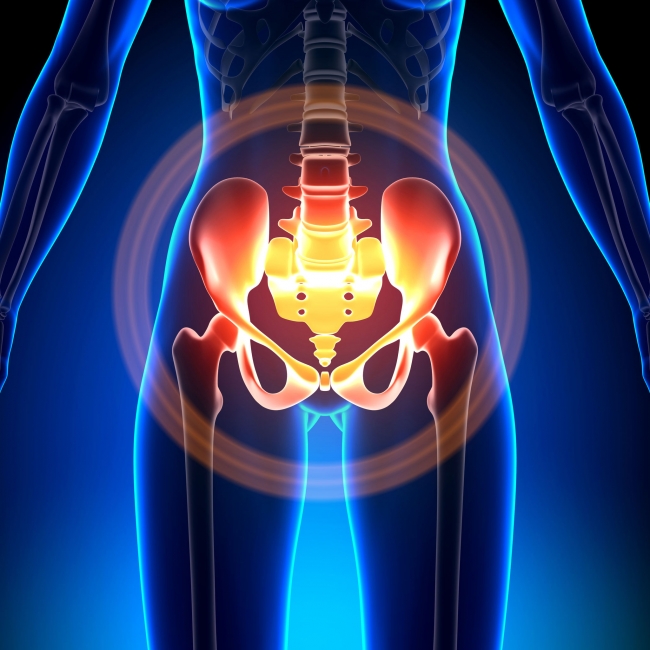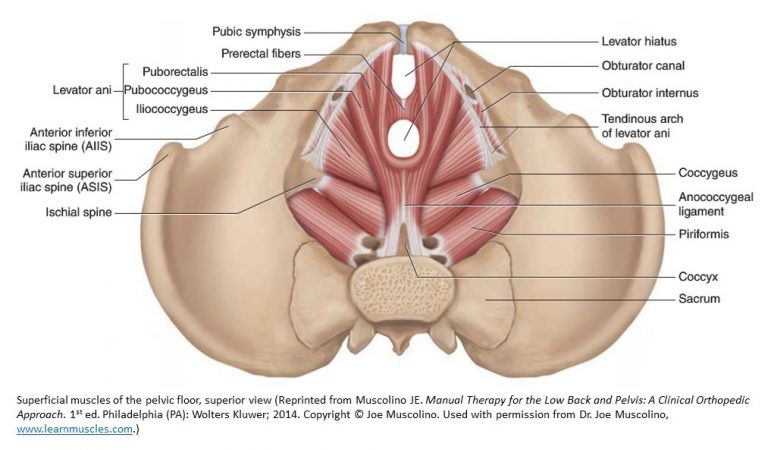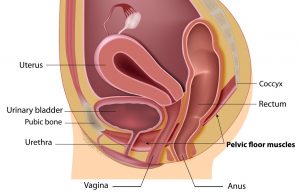The bones of the pelvis fuse early in life so we are left with three bones – the innominates (ilia and ischia) on both sides and the sacrum at the back and centre (the lower part of your spine). The main joints within the pelvic ring are the left and right sacroiliac joints and the pubic symphysis at the front. The thigh bones attach to the pelvic acetabulums via the hip joint.


The pelvic floor is a myofascial sheet at the bottom of the pelvis that supports your pelvis and abdominal organs. The pelvic floor works in synergy with your abdominal wall (which attaches to the front of our pelvis along the pubic bone), respiratory diaphragm and back muscles to create the canister of “core muscles” that supports your trunk.
Myths about the Pelvis
- I’m pregnant so I just have to put up with my pelvis being sore.
No!
You should need to put up with extra muscle and joint pain just because you’re pregnant.
Pregnancy is simply placing extra demands on your body so it is having to function at a higher level. Hormones create more joint laxity and second and subsequent pregnancies continue to stretch what was stretched last time. The growing baby and placenta add more weight and take up more space in your pelvis. Your pelvis is working harder. It pretty much all cases, the pelvis was a bit dysfunction prior to pregnancy, but not quite enough to be painful (often). So you got away with a weak core, and you could stretch out your tight hips. But that non-optimal movement and strength that you could get away with before, can’t be overlooked as easily now.
The point is – yes, your body is under increased demand. But if we can balance the muscles around your pelvis (release what is tight, strengthen what needs to support you more) then we can optimise how your pelvis functions so that those same ligaments and muscles don’t become a source of pain. It’s never too early or late to get started.
2. I’ve had a baby (one or more) so I just need to accept that I will leak when I cough, sneeze or laugh.
OR
3. I’ve not had a baby, so my pelvic floor is fine (whether or not I leak).
Firstly, leaking is not a good way to judge how well your pelvic floor is working.
Secondly, leaking is not something you should be encouraged to put up with at any age without further investigation and intervention because in most cases, it is so preventable and changeable.
So what causes us to leak?

The first mechanism that keeps us continent is the sphincters – the round muscles around the opening to the urethra. The second, back-up mechanism is the pelvic floor muscles (levator ani).
Leaking from a cough, sneeze, laugh or running is called “stress urinary incontinence” (SUI). When the pressure on the bladder increases above the pressure in the urethra or the urethra can’t close properly, urine will leak out.
Factors that put extra pressure on the urethra (and cause SUI)
- Muscle tension and gripping around the ribs and abdominal wall
- Poor core muscle activation and co-ordination
- Gravity: run, jump, sneeze, laugh
- Increased intra-thoracic pressure (cough, sneeze, laugh)
Factors that make it harder for the urethra to close properly (and also cause SUI)
- Childbirth may have stretched some tissues around the urethra
- Athletes, especially those training at high levels from a younger age, may strain their pelvic floor and core muscles
- Hormone changes (drop in oestrogen)
4. I’m so embarrassed about talking about leaking. I would rather just put up with it until I die!
SUI is associated with an increased risk of prolapse – where your pelvic organs bulge down into your vagina. It is way better to prevent than have to fix this problem (which may require surgery). Please, please, please do yourself a favour and act on it now! Learn more about prolapsed here.
5. My pelvis is out. I need someone to put back in.
It can sure feel like something is out of place when you have pelvic girdle pain. But the truth is that the pelvis is a very strong structure with small degrees of movement. More often, there are imbalances of muscle activation around the pelvis. This can be improved with ‘manipulations’ (short, fast manual pressure) and also with massage and release techniques. It’s common for your body to have developed certain habits around which muscles become overactive – if your physiotherapist can identify this muscle, they can show you how to stretch and release it.
6. I’m a guy – do I even have a pelvic floor?
Yes. All humans have a pelvic floor that plays a key role in continence, support of our abdominal organs and is one of our core muscles. Men’s pelvic floors can also be dysfunctional for other reasons. For example, prostate surgery is one cause unique to men.
Common Pelvic Problems We Treat
- Sacroiliac joint pain (SIJ)
- Sciatica
- Muscle spasm
- Hamstring tendinopathy
- Gluteal tendinopathy
- Pelvic girdle pain – low back pain, pain across the back of the pelvis
- Coccyx injuries
- Pubic symphysis pain
What does a dysfunctional pelvis look and feel like?
Any one (or more) of the following means the pelvis is not functioning at its 100% optimal level.
- Pain in or around the pelvis (front or back)
- Difficulty with wide leg positions when sitting or standing (for example at yoga)
- Dislike of walking – standing and sitting tall are usually better
- Sometimes, an unhappy pelvis won’t like laying on your back – side lying, on your tummy or all fours might be more comfortable for resting or exercising
- Difficulty or pain getting into or out of the car
- Leaking when you cough, sneeze or laugh (as mentioned above)
Common Causes of Pelvic Pain
- Fractures and sprains of the pelvis require large forces – fall from significant height, car accident etc. (stepping off a curb or step funny is not enough to move a joint of the pelvis).
- Pregnancy
- Childbirth
- Falls
Disease processes within the abdomen create pain that alters the function the muscles of our abdomen and pelvis. Examples include:
- Endometriosis
- Irritable bowel disease (IBS)
- Crohn’s disease
- Bowel adhesions
How We Help
At PhysiYoga we aim to assess your whole body to determine what pressures your pelvis is under.
- Pain relief with joint and muscle releases or dry needling
- Real time ultrasound assessment of your core muscles (abdominal wall and pelvic floor) to help you effectively retrain your core muscles
- Advice and education regarding pelvic health
- Assessment of how the rest of your body is influencing your pelvis (and vice versa)
- Postural assessments
- Provisions of taping, braces and supports
- Pilates and Yoga
- Post pregnancy assessments
There are different types and causes of incontinence. Talk to your GP or gynaecologist for advice. Or talk to your physiotherapist on your next visit.
If you think you suffer from SUI, then we can help identify the contributing factors and create a plan to resolve the issue. We first look at your whole body. If this doesn’t fix the solution, we have a trained pelvic health specialist who can perform a detailed assessment of your pelvic floor and give you a clear picture of what you need to work on.

